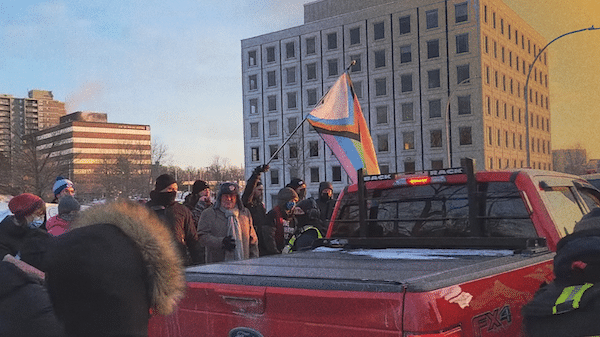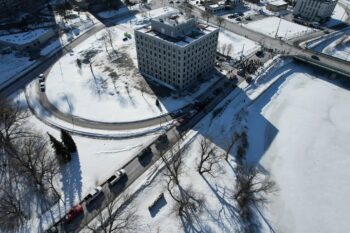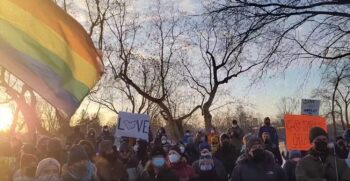The metal latches on the megaphone stuck to my hands as I loaded it into the car at 8:30am. It was -22C outside, and everything had frozen overnight. I chiseled the ice off the door handles, put on my mask and gloves, and set off for Centretown Ottawa with a weight in my stomach.
I had no idea that a few hours later we’d be delivering a major political blow to the “Freedom Convoy.”
The night before, I had received a text message letting me know about the plans for an action. Organizers had heard that a so-called “Blue Collar Convoy”was aiming to drive to Parliament with more supplies—and they had posted their route on Facebook.
Once we confirmed we had enough people, the organizers let me know the plan: we would bring bicycles, traffic cones, and anything else that would help stop traffic. Two dozen of us would block an intersection along their route, cutting off the support convoy from their destination.
When we arrived the next morning, I recognized some people through their masks and toques. There were scouts along the route watching for the convoy’s progress. We didn’t think we could completely block them, but we would consider it a victory if we delayed them for a couple hours and made them re-route. We planned to be done by later that morning.
But nine hours later, with evening falling, our tiny protest with a few people had turned into a block party of thousands. There was hot food, and music blasting from loudspeakers. As news spread on social media, people from across the city flowed in. When word went out about possible threats of violence—as far-right leader Pat King issued a call to his supporters to head in our direction—the crowd swelled further.
The assembled crowd shut down the convoy’s route and blocked more than 30 trucks. When we finally let them through, one by one, it was only on the condition that they give up their jerry cans full of gas. More importantly, we sent a powerful message that we could take back our city, instill hope, and demand real justice for workers, not the fake freedom promised by the convoy. By the day’s end, the action had been irreverently named after a local bridge, and was trending on Twitter under the name: the Battle of Billings Bridge.
In the fight against the far-right, it is this sort of direct action, rather than policing emboldened by an authoritarian Emergency Act, that will undermine sympathy for the convoy’s politics and win long-term support for a progressive agenda.
Legitimate anger—and an illegitimate agenda
Over the past weeks, I’ve spent time walking around Parliament and talking to participants in the convoy.
Some on the Left have written off the convoy as a movement exclusively of small capitalists, owner-operators of their trucks, and far-right wing operatives with ties to extreme-right vigilante and white supremacist groups, all of them backed by wealthy donors. And that’s certainly true of those who have been able to camp there for weeks, as well as the architects (some of whom have set up a “war room” in a four-star hotel downtown).
But they’re a minority. The people I met were unemployed, or were just there for the weekends, and most working class. They gave no indication of being committed to right-wing principles but have clearly been swept up by the protests. They are being immersed in the far-right’s ideology, a vortex of conspiracy-ridden, often racist rhetoric blasted regularly from the stage set up right next to Parliament, as obliging police look on.
And many working class people are finding some reason to feel affinity for the protests. According to a poll conducted last week, 46 per cent of Canadians say they “may not agree with everything” the trucker convoy says or does, but the frustration of protesters is “legitimate and worthy” of sympathy.
While not everyone I met in downtown Ottawa is right-wing, what they all are is angry—pissed off at government policies, and furious at Justin Trudeau. And they’re not wrong to be.
Life has gotten worse in almost every way since the pandemic started. Housing and rental prices have skyrocketed, food prices are up, thousands have lost their jobs, and government supports like CERB ended over a year ago. If workers get sick from COVID, they are left on their own. At every step of the way, provincial and federal governments have pushed all the costs and risks of the pandemic onto individuals, while ensuring that corporate profits soared.
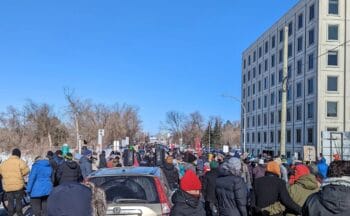
As word circulated, thousands in Ottawa showed up to reinforce the blockade at Riverside and Bank street. Photo: @NicoleLWT
With the broad left missing in action, and the NDP and unions falling down on the job in particular, there has been no bold and compelling vision on offer, and the right has seized on this vacuum to misdirect all that legitimate anger. It was this dynamic that our action sought to shake up.
Ottawa summons an opposition
After three weeks of the convoy occupying Ottawa, we knew our response would have to start small.
Many residents were afraid to leave their homes, let alone organize a counter demonstration. It’s hard to describe the level of fear that most people in town feel, most of all those living near the occupation. Almost every day there are reports of convoyers attacking elderly and vulnerable people, threatening and robbing homeless shelters, attempting to burn down apartment buildings with residents locked inside, and sending death threats to the 21 year-old woman who filed the injunction against honking.
The previous weeks saw several meetings to plan a community response, but people were divided. I didn’t attend those first meetings—I’m told they focused on mutual aid, safety walks and strategies to keep Centretown residents safe. These were important measures, but we knew we needed more. Moves to hold a public demonstration, however, went awry, with local groups and politicians discouraging them due to safety concerns.
Finally, a group of well-positioned labour union staff members, a handful of rank and file members, and a couple of elected leaders got the ball rolling. Hassan Husseini, Alex Silas, and Chelsea Flook, elected officers or staff with the Public Service Alliance of Canada, called a cross union meeting.
The ad hoc labour coalition decided to tactically sidestep the issue of vaccine mandates and to avoid framing the rally as a head-on counter protest. Instead, we’d call for genuine solutions for working people: 14 paid sick days, a $20 minimum wage, increased job security for truckers, nationalizing long term care, better health care, and manufacturing and freely distributing N95 masks and rapid test kits in Canada. These are solutions that would be supported by many sympathizers of the convoy, even some participating actively in it, but which those on the far-right would certainly not support.
Calling ourselves Community Solidarity Ottawa, we announced a rally. We knew that it was a baby step: it wouldn’t get the convoy out of town or disarm its far-right leaders. But before we could do more, we need people in Ottawa to start to feel comfortable in the streets again and secure in our ability to organize.
Strategically, the most important thing was to engage as many people as possible, so we chose a march route that would avoid the downtown occupation. We held a training for 50 marshals and legal observers. We covered de-escalation and non-violent intervention techniques, tips for observing and interacting with the police, the role of street medics, and having scouts at every point of the route to watch for convoy members.
It was a tremendous success. Marshals counted 4,000 people, and neighbours were overjoyed to see us. Several people draped in Canadian flags yelled at us, but really the convoy paid us no attention. We were at least 20 blocks from Parliament, and with Doug Ford declaring an emergency the night before, we seemed insignificant to them. They were partying in hot tubs and saunas, and dancing to DJs on a stage bigger than last year’s Canada Day celebrations. We were building our capacity and confidence to do more.
Holding the line
Arriving at the blockade on Sunday we found out that the night before, Sean Burges, a senior instructor at Carleton University, had independently also suggested a blockade in another location. After posting the idea in a dog-walking group on Facebook, residents of the affluent Old Ottawa South neighbourhood had joined him the next morning at Riverside and Bank.
Our group decided to move from our spot and provide reinforcements at their spot. We helped set up an additional blockade on the rear-end of the convoy as well, effectively immobilizing them.
As word spread on social media, more and more people from across the city began to show up.
During the next hours, we facilitated small assemblies sharing ideas about what to do next. A local progressive politician who was out in support relayed that the police had said they would escort the vehicles back to their staging ground in the east of town, but this was flatly rejected. As the numbers grew, we encouraged people to collectively decide the level of risk they were ready to take, and what victory would look like for them.
As the afternoon got late there were moments of anxiety: besides attempts by Pat King via livestream to dispatch his supporters, who thankfully never materialized, there was also pent-up anger from our own ranks that nearly boiled over. Some started chants to confiscate the vehicles of the “blue collar convoy,” and even put the drivers in handcuffs.
Because there was no clear leadership structure in place, it was hard to coordinate and respond to developments on the fly. A few of us suddenly found ourselves trying to liaise with police and politicians, deescalate both the convoyers and residents, and figure out a safe exit strategy for everyone.
Eventually we reached a compromise: stay and celebrate our act of resistance until dark, then release convoy participants one at a time, after having forced them to remove the flags and signs from the vehicles and to hand over their jerry cans (something police refused to confiscate). As the blockade wound down, we gathered up all the remaining food and supplies people had sent from across the country and donated them to local shelters. We asked supporters to leave in groups. Everyone made it home safe.
The wrong kind of emergency response
The day after the blockade, Trudeau implemented the Emergency Act, which effectively suspends the Charter of Rights and Freedoms. It replaced the War Measures Act, which in 1970 was used to send the military to occupy Quebec and crush the independence movement.
Over the last three weeks, Ottawa Police and the Ontario Provincial Police have stood by and even encouraged the convoy as vigilantes broke laws and terrorized people. The police have all the powers (and more than enough resources) they need to dismantle the convoy. Yet they have chosen not to act. With no resistance from the police and capitulation from politicians, convoyers have become bolder: setting up permanent structures and targeting schools, bridges and airports.
It’s painfully obvious how differently they have treated the convoy compared to Indigenous land defenders, Black Lives Matter protesters, encampments of homeless people, and labour strikes. This is not surprising. The convoy is not actually a threat to the power structure, even if its appearance might discomfort the Liberals.
Unlike the Left, whose demands are in direct opposition to corporate greed, the convoy demands an end to vaccine and mask mandates, measures that would increase private profits at public expense. The rich get richer and the poor get poorer—and sicker.
The Left calls for things like expanded social programs, climate action, workers’ rights, and land back—all of which directly interfere with the ability of the rich to exploit workers and the planet for unlimited profit.
The Emergency Act in effect imposes martial law and allows the government to limit and ignore democratic rights and freedoms of civilians. We know the federal government already targets and surveils Indigenous, Black, Muslim, and racialized communities, as well as trade unions and climate activists. Now the federal governments—or its potential Conservative successors—will have even greater resources and power to do so, with little if any oversight.
Instead, here’s what should be happening.
Plans are in the works for another, hopefully much larger mobilization this coming weekend, with details to be released on Community Solidarity Ottawa’s website. We have also heard word that our actions have inspired others to consider and start planning their own non-violent direct actions and blockades.
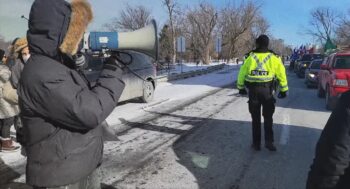
Police asked for the convoy supporters to be let through to return to their supply base, but the blockade held the line. (Photo: James Hutt)
To rid ourselves of the convoy and the extreme right ideology it’s nurturing, we need to build support for a strong multi-racial working class movement, winning reforms that improve the lives and protect the health of all.
The power of connection and persuasion
Sometime in the morning on Sunday, after both ends of the blockade had been secured, people began initiating conversations with the convoy supporters.
I approached one man named Dieter. Dressed in a camo jacket and rubber boots, he was sitting on his tailgate, smoking. “Sorry you’re stuck here,” I said. “I want you to know that I understand why you’re here. But what the convoy is calling for won’t help the majority of people.”
He broke down and started crying. “I’m fed up,” he said,
but I never meant for it to get like this.
I told him I understood, that he was right to be pissed off at the government. In fact, I didn’t actually disagree with the tactic of the occupation, or the blocking of streets and bridges. These are all tactics the left has used and will need to use again. The difference was the goal.
I invited him up to the front for coffee and donuts. He was hesitant. He asked me to stick with him so he wouldn’t get swarmed by the crowd. I poured him a coffee, gave him food and hand warmers. Soon people were striking up conversations with him.
I went to deal with other things but caught glimpses of him throughout the day. He spent it out of his truck, always with a crowd around him, being asked about his perspective and engaged with discussion. Crossing paths later, after having seen the sound system unloaded, the pizzas arrive, and the decision-making assemblies take shape, he turned to me, laughing, and said,
damn, you guys organize better than we do.
Dieter may well still join the convoy occupation, but there’s no doubt he came away with a new openness to working-class and progressive politics.
At sunset, he was the first to take down his flags.

